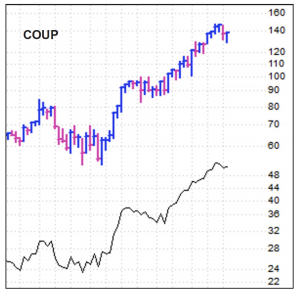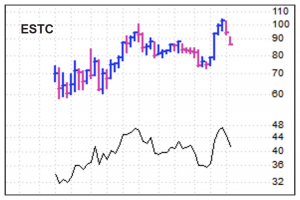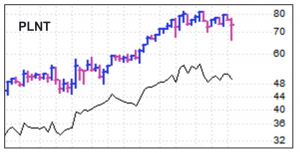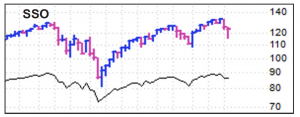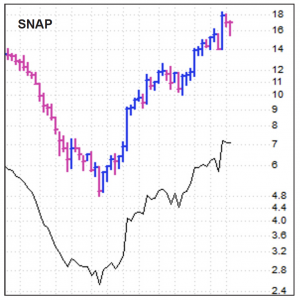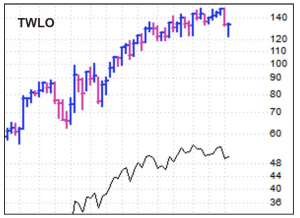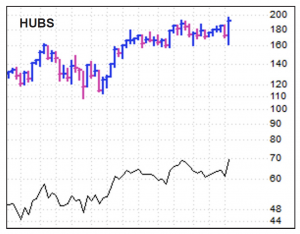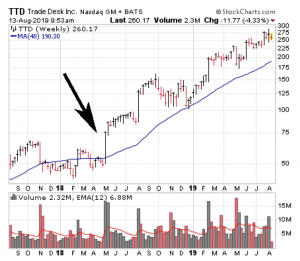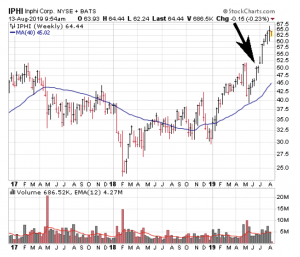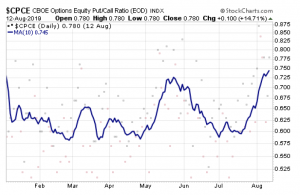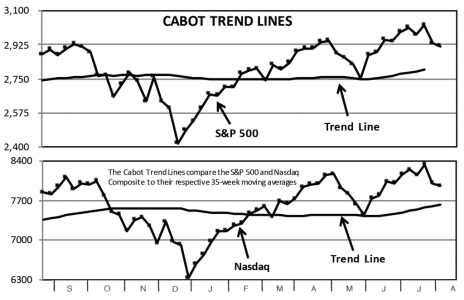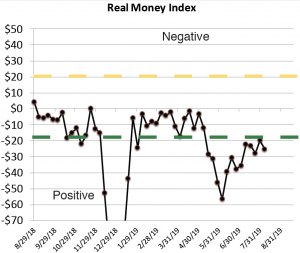This week’s Cabot Growth Investor issue is two days early, because the rest of the week is filled by the Cabot Wealth Summit, which brings all our analysts to Salem to meet subscribers face-to-face and fix all the world’s problems—or at least help them become better investors.
The market remains news driven, with some soothing U.S.-China trade news sending the major indexes back up. Even so, the intermediate-term trend remains unsupportive, so we’re still playing some defense—we’ve pruned our worst performers and losers, but are also holding our resilient performers. From here, we’re just taking it day to day, willing to buy some fresh leadership if the bulls retake control, but content to sit tight with some cash until that happens.
In tonight’s letter, we write a bit about the type of stocks we’re honing in on for the next sustained advance (early stage), touch on the bottom dropping out of investor sentiment (good for the longer-term outlook) and dive into all our stocks and plenty of new ideas as well.
Cabot Growth Investor 1426
[premium_html_toc post_id="184201"]
Play Some Defense
Usually, when the market is doing well, stocks aren’t affected much by the news of the day. That’s not to say individual stocks don’t get pushed around, but for the market as a whole, worrisome headline news usually goes the way of water off a duck’s back.
But 2019 has been unusual in that sense—it’s been a good year thus far, but reports about the Fed, U.S.-China trade and various economic reports have led to plenty of ups and downs. The latest news-driven event came two weeks ago, when the “new” tariffs on Chinese imports led to a stampede out of stocks, cracking the intermediate-term of some leaders and flipping our Cabot Tides to negative.
And that means we’re following our usual correction game plan: It’s time to play some defense by cutting back on most new buying, pruning our worst performer or two and keeping losers and laggards on tight leashes—all while still hanging onto our strong actors. Since the last issue, we’ve sold all or pieces of four stocks, leaving us with 33% in cash.
Longer-term, most of the evidence remains bullish (including the pervasive and building pessimism out there—see page 7 for more), so until proven otherwise, we’re sticking with the viewpoint that this is a correction within an ongoing bull market. In the near-term, we see two possible scenarios.
The first is that the August selloff is basically one big shakeout on obvious news; the obvious rarely works for long in the market, and when combined with plenty of resilience among growth stocks (including many recent earnings winners, a bunch of which are on our watch list), we’re open to the possibility of a quick bottoming process and upside resolution. Today’s action, for instance, was very encouraging.
The second is that this will turn into more of a “regular” correction—two to four months of ups and downs amidst a barrage of worries and bad news, which will break some more stocks but also allow leaders to build launching pads.
We’re still leaning toward scenario two given the fact that many stocks could use a rest. But the good news is that we don’t have to guess—simply taking things on a day-to-day basis will keep us in gear.
[highlight_box]WHAT TO DO NOW: Be cautious. During the past couple of weeks, we’ve taken the rest of our profit in Twilio and sold our half positions in Elastic and Zillow, as well as a piece of ProShares Ultra S&P 500 Fund, leaving us with 33% in cash. But we’re still holding many strong names and have a burgeoning watch list for the next advance. [/highlight_box]
Model Portfolio Update
If you’ve been reading us for a while, you probably knew the Model Portfolio’s thinking once our Cabot Tides turned negative a week ago—cut losers and laggards, limit new buying and build up some cash that will both cushion the blow from any further market weakness and provide us with solid buying power for the next uptrend.
That said, we’re not running for the hills; so far, the indexes are hanging in there and many stocks (including some we own) are acting resiliently, with a bunch we’re watching reacting well to earnings even when the market was falling apart. That doesn’t mean you should be buying a bunch of stuff here—good stocks can go bad in a hurry if we have another leg lower—but it’s a positive sign that leadership wants to head higher once the market rights itself.
In total, we’re comfortable with our current stance and are open to moving in either direction going forward—possibly adding a strong stock if it approaches support and the market firms up, but also selling more should the bears really take a bite out of things. Tonight, though we’ll continue to practice patience.
Current Recommendations
HOLD—Blackstone (BX 48)—If the current market correction turns into a deep, multi-month affair, BX could find its way to the chopping block—Bull Market stocks aren’t a great place to be in a down market, and we don’t have much of a profit cushion to play with. (A close much below the recent low of 43.5 would be iffy.) But right here, the evidence remains mostly positive, both in terms of the market’s longer-term outlook and Blackstone’s ability to capitalize on it. Combined with the fact that the stock’s original breakout came just four months ago, we remain optimistic there’s upside ahead. Fundamentally, the only news to break recently was that Blackstone took a modest position ($560 million) in a private-equity peer. If you own some, we advise sitting tight with a mental stop in the low 40s.
BUY—Chipotle Mexican Grill (CMG 817)—Many restaurant stocks have been acting well, bolstered by strong earnings reports and their reliance on a healthy consumer spending environment. Chipotle looks like the emerging blue chip play in the group, with shares actually nosing out to new price highs last Friday before pulling back. Bigger picture, we continue to see huge earnings potential: Consider that Chipotle’s peak earnings were nearly $17 per share back in mid 2015, nearly 50% higher than the firm’s current bottom line despite steady growth in the store count during the past four years. Thus, just on a “catch-up” basis, CMG likely has plenty of room to grow, and that doesn’t take into effect new initiatives on digital ordering/pickup, the menu and so on. A drop back into the mid 750s might prompt us to go to Hold, but right now, we’ll stay on Buy, thinking modest dips of 10 or 20 points could be bought if you’re not already in.
HOLD—Coupa Software (COUP 138)—Cloud enterprise software stocks have definitely been one of the leading areas of the market this year, but now they’re a mixed bag, with some having cracked their intermediate-term uptrends, while others, like Coupa, are still holding up pretty well. Frankly, we want to give our position every chance to hold up given the common-sense growth story here. We see no reason COUP’s rapid, reliable growth won’t continue for many years and spin off more free cash flow (20% of revenues in Q2!), which will continue to attract more big investors (481 funds now own shares, up from 369 six months ago and 306 a year ago). That said, we’re simply sticking with our plan—if COUP closes much below our cost (around 123), we’ll cut bait, but above there, we’re holding on tightly to our shares. The next quarterly report is due out September 3.
SOLD—Elastic (ESTC 86)—Sometimes a stock takes off just after our entry, but sometimes luck isn’t on our side. That was the case with ESTC, which we bought the very day the S&P 500 hit its recent peak. Thankfully, we only entered with a half position, so the loss (12%) was no huge deal. We have gotten a couple of questions about whether Elastic’s longer-term outlook remains bright. Fundamentally, we’d definitely say yes, but chart-wise, the stock now needs work; following its failed breakout, ESTC isn’t in an uptrend and, at best, needs time to rebuild. We think there will be better names to buy when the bulls return to the market.
HOLD—Okta (OKTA 133)—OKTA is fumbling around in no-man’s land, neither strong (no net progress since early June) nor weak (still hanging around its 50-day line and above last week’s low). If you haven’t taken partial profits (we did so a few weeks back), we still think that’s a good idea given the stock’s run and recent stalling out. Overall, though, we’re giving our remaining position room to breathe, thinking the hugely bullish fundamental story can continue to play out. One interesting nugget that hints at the company’s upside potential is that, in the last quarter, the number of clients that pay Okta $100,000 or more annually grew by 104 firms—but more than half of those were entirely new clients (not ones that signed up before and expanded their purchases), a very strong sign that big enterprises see Okta’s identity solutions as a must-have and are signing up right quick. None of that means the stock can’t pull in further, of course, but with a good profit cushion we’re comfortable giving our remaining shares of OKTA some rope. Hang on.
HOLD—Planet Fitness (PLNT 73)—PLNT is the stock closest to the edge for us—it came close to being punted after a sour earnings reaction last week but found support. But then on Monday, a column in the Wall Street Journal opined that the stock was vulnerable due to its huge run and elevated (in their view) valuation. If you want to use a looser stop, the 200-day line (at 66 and rising slowly) is one option, but we’re going to stick with our mental stop near 70 (give or take a few dimes); a meaningful close below there will have us booking the rest of our profit.
HOLD—ProShares Ultra S&P 500 Fund (SSO 125)—There are no sure things, but the majority of the longer-term evidence (trend, sentiment, blastoff indicators, health of leading stocks) remains positive for the market, so we’re comfortable holding a “core” position in a leveraged long fund like SSO. That said, last week, we did trim our most recent purchase that was showing us a loss (as we’re wont to do when the Tides are negative), leaving us with a more reasonably sized position (around 9% of the portfolio). If you don’t own any SSO and want to nibble here with a 10%-ish loss limit, we wouldn’t argue with you. But officially we’ll stay on Hold, respecting the fact that the intermediate-term trend remains unsupportive.
BUY—Snap (SNAP 17)—SNAP’s had a big run since the start of the year, has surged since breaking out in early June and just sold a good-sized convertible note offering ($1.1 billion), which is dilutive. Despite all that, the stock continues to act well, pulling back only to its 25-day line last week before bouncing. We don’t expect major upside if the market continues to futz around, but shares continue to act as if big investors are building positions. A drop to 14 or below would be a red flag, but at this point we’re holding on tightly to our shares, and if you don’t own any, think you can start a small position around here.
SOLD—Twilio (TWLO 131)—There’s no denying that Twilio is a great company with a big opportunity ahead of it. But there’s also no denying that the stock has lost momentum—TWLO began doing a lot more chopping than trending starting in May, showed no above-average buying during the market’s June/July upmove and then decisively broke its 50-day line on six straight days of heavy-volume selling. (Relative to the market, TWLO is no higher now than in mid-March.) Because it was our weakest holding, we took the rest of our profit last week. If TWLO shapes up in the weeks or months ahead, we could always revisit it, but the odds favor the stock needing more time to rest following a great run over the past 15 months.
SOLD—Zillow (Z 37)—Zillow was a victim of earnings season, though not necessarily because business was slumping—the firm’s Offer segment came through as expected and management hiked revenue guidance going forward. But Wall Street was in no mood for the company’s continuing losses and increased investment and uncertainty in the meantime. We got out of our half position for a modest loss; between this and Elastic, we lost a total of just 1% or so from the Model Portfolio, so no major damage done, and now we have the opportunity to ride more powerful leaders during the next upmove.
Watch List
Carvana (CVNA 80): CVNA has come to life following another great quarterly report (sales up 107%, cars sold up 95%, gross profit up 181%). It’s still bleeding red ink, but we think the company has a bit of Amazon-ness to it as it shakes up a gargantuan ($764 billion) industry.
Guardant Health (GH 101): GH has given up most of its earnings gains, but that’s not a sin in an environment like this. The firm’s blood biopsies for various cancers (especially lung cancer) work as well as most tissue biopsies but aren’t invasive and give quicker results.
Inphi (IPHI 64): IPHI is getting tempting—after breaking out of a two-year consolidation and rising 12 weeks in a row, the stock is beginning to pull back on low volume. Combined with its great story (leader in high-speed network interconnects) and growth, we think the stock can do very well in the next market uptrend.
Novocure (NVCR 89): NVCR is still extended, but the fact it’s held up so well this month is a good sign that big investors are trying to build positions. The firm’s Optune cancer treatment system is driving huge growth.
Roku (ROKU 135): ROKU has gone bananas since its earnings report last week as the trends toward cord-cutting and streaming video accelerate. It’s worth watching but we need to see a pullback to enter.
Zoom Video (ZM 95): Right here, ZM isn’t strong enough for a new buy, but we think its eight-week rest period after its big post-IPO run is constructive. Growth is outstanding; the next quarterly report is due September 5.
Other Stocks of Interest
The stocks below may not be followed in Cabot Growth Investor on a regular basis. They’re intended to present you with ideas for additional investment beyond the Model Portfolio. For our current ratings on these stocks, see Updates on Other Stocks of Interest on the subscriber website or email mike@cabotwealth.com.
CrowdStrike (CRWD 100)—We’ve been harping on so-called “new age” cybersecurity stocks all year; as opposed to legacy players, these companies were built from the ground up to protect against threats in the new cloud-based and mobile (workforce and devices that access a firm’s network) world. Our pick was Okta, and it’s done well for us, but another one to watch is CrowdStrike, which came public in early June. The company’s platform (which it dubs a Security Cloud) looks like a huge step forward for endpoint protection (securing the devices that connect to a big network) and should have applications for other areas like IT operations and vulnerability forecasts as well. What makes the platform unique most is that it’s self-learning—it leverages crowd-sourced data, automatically applying any intelligence gained to all customers across its platform, in effect boosting CrowdStrike’s competitive advantage with every new customer. (All told, management said the offering processes, correlates and analyzes more than one trillion events per week!) In essence, CrowdStrike has a better mousetrap for today’s advanced cyberthreats. The firm now has more than 3,000 customers (including 40% of the Fortune 100 and nine of the top 20 banks in the world), up about 20% from the prior quarter, and once they sign up, they use more and more (same-customer revenue growth is miles above 20%). Revenues rose 103% in the quarter ending in April, while the sub-metrics were even more impressive (subscription revenue up 116%, annualized recurring revenue up 114%). As mentioned above, the stock is new, but we like that (a) it’s well-traded, trading north of $200 million per day, and (b) it’s been well-controlled, with resilient action during the market’s August wobbles and new highs today. The next quarterly report is due out September 5. It’s not cheap, but CrowdStrike has a unique, powerful story.
HubSpot (HUBS 193)—Most cloud-based enterprise software providers focus on helping clients improve their own operations (human resources, communications, planning, project management) or security (like CrowdStrike), but HubSpot helps with the other side of the fence—the firm offers a top-notch marketing platform, mostly for small- and mid-sized businesses (more than 64,000 total customers at the end of June, up 35% from a year ago). The whole idea here revolves around the new, more effective way of marketing—out are cold calls and spam emails, replaced by useful free content that attracts, engages and converts leads. HubSpot has expanded from its original roots to offer sales and service offerings for all sizes of companies (starts at just $50 per month but goes up to thousands for enterprise users), but it’s still best known as a leading provider of marketing help to smaller outfits that need help getting and keeping customers. HubSpot has about as good a record of growth as any software firm out there—revenues have grown between 33% and 39% each of the past nine quarters, and as opposed to many software names, it’s solidly profitable both in terms of earnings (triple-digit earnings growth six quarters in a row) and cash flow (up 47% so far this year, totaling about $0.80 per share). Interestingly, the stock hasn’t been a hot performer this year—HUBS made no net progress from September of last year through early last week (nearly 11 months) before earnings pushed the stock back toward its all-time highs. If it breaks out and the market returns to health, HUBS could finally be ready for a sustained uptrend.
PagSeguro (PAGS 47)—Emerging market stocks seem like the last place you want to be given this week’s Argentina elections and the never-ending U.S.-China trade tussle. But PagSeguro is in a bull market of its own. Based in Brazil, the company sounds a lot like it has a shot to be the PayPal of that country—the firm’s core payments offering (including point-of-sale devices) had 4.4 million (mostly smaller) merchants as of the end of April (up 43%) that transacted R$24.4 million in Q1 (up 70%), and that segment continues to have great potential: just 60% or so of people over 15 in Brazil have made a digital payment, vs. 92% in the U.S. (Moreover, just one-third of Brazilians have a credit card compared to 60% in the U.S.) And now the firm is expanding into more general money transfers and banking offerings, including wire and person-to-person digital transfers, prepaid cards and general digital account and banking services right through its smartphone app, which is sure to attract millions of people in that country who are unhappy with their banking options. There’s competition and overseas risks, but the story and current numbers are big, as are expectations (analysts see earnings up north of 30% both this year and next). As for the stock, it was hanging around the mid 20s in May when Q1 earnings kicked off a persistent run to 49 before finally pulling back with the market. It’s a good story, has good numbers and has a nice chart—though earnings, due out Thursday (August 15) evening, will be key.
Chip Stocks Beginning to Look Interesting
The reason we’re publishing this week’s Growth Investor issue a couple of days early is because this is the week of our Cabot Wealth Summit, where we present to, rub elbows with and otherwise hobnob with a few dozen attendees. I have two presentations—the first is always my take on the market (both long- and near-term view), and my second this year is about the most important lessons learned (from a stock picking, chart and psychological perspective) in my 20 years of grinding it out for Cabot.
One of my slides is something I’ve written about before and is timely today: For new buying, you’re better off looking for “early-stage” situations—stocks that have broken free from their first consolidation sometime in the past few months—rather than later-stage names that have already run a year or two.
“But Mike,” most say, “how do you know if something is later stage? Don’t some of these big winners just keep going? And don’t some early-stage stocks fail?” Of course they do—there’s no surety in the stock market, and there’s no way to know where exactly a stock is in its run (first inning, sixth inning, etc.). But the market is an odds game, and the odds of an early-stage name making a big, sustained run is generally bigger than stocks that have already had huge runs over a 12-month-plus stretch.
Take Trade Desk (TTD), for example, which has been and remains a leading growth stock. There’s nothing bad we can say about it—the story (leading the new programmatic digital advertising movement), the numbers (sales up 42%, earnings up 58% in Q2) and chart (resilient recent action, with a new relative performance peak on Friday) all look just fine. But to us, the stock’s original change-of-character breakout came in May 2018 (15 months ago) at around 61 per share (up 350% since then).
Could TTD continue to rally? It’s definitely possible, and if we owned it with a big profit, we’d definitely ride the longer-term uptrend (likely with a stop near the 40-week line around 190). But we’d also say the risk of some pent-up profit taking being unleashed (possibly due to some bad news or simply a weak market) is growing. Doesn’t mean it’s going to happen, but the risk is rising.
Conversely, there are names like Inphi (IPHI), Guardant Health (GH) and Carvana (CVNA), all of which look like they’re earlier stage—IPHI just broke out of a 28-month range, GH just came public in October of last year and CVNA is near the top of a year-long range following a five-month run from its original breakout. If the market returns to health and each respective management team pulls the right levers, all three have a shot to have solid, sustained runs.
As we wrote above, it’s always possible these three names fail while TTD continues to chug ahead. But history tells us that new buying focused mostly on fresher situations gives you a greater chance of catching a real tiger by the tail.
Stampeding to the Sideline
We don’t usually write too much about investor sentiment since our decisions are (mostly) based on our market timing indicators and the action of leading growth stocks. But this year has been so unusual in that (a) the market has done well but (b) investors have been so hesitant to embrace it. And that’s once again being seen in the reaction to the August selling.
For instance, the equity put-call ratio actually hit its highest level of the year on August 2, and the 10-day moving average (shown in the chart) is doing the same. In terms of money flows, last week saw the largest weekly outflow ($25 billion!) since last December and was in fact the largest non-December reading in well over a decade. (December money flows can be affected by year-end tax planning and repositioning.)
And then there was the AAII sentiment survey of individual investors, which showed the second fewest number of bulls and third largest number of bears since mid 2016! None of this means the market can’t go down for a while if it wants to, but it’s a good sign that a ton of money remains on the sideline—buying power that will eventually find its way back to stocks and allow the bull market to resume.
Cabot Market Timing Indicators
The odds strongly favor this still being a bull market, but the near-term remains iffy with the intermediate-term trend pointed down. You should still hold your profitable, resilient stocks, but you should also prune losers and laggards and hold some cash until the storm has passed.
Cabot Trend Lines: Bullish
The Cabot Trend Lines have pulled in with the market but remain solidly bullish—even after the past two down weeks, both the S&P 500 (by 3.8%) and Nasdaq (by 4.3%) closed clearly above their 35-week moving averages. Thus, until proven others, the bull market remains alive and well.
Cabot Tides: Bearish
Our Cabot Tides are currently negative, with all five indexes we track (including the Nasdaq Composite, daily chart shown here) at or below their lower (50-day) moving averages. It’s possible last week’s low was a big shakeout, but as we’ve written elsewhere, the onus is on the bulls to prove that they’ve retaken control. Right now, with the intermediate-term trend still unfavorable, being cautious makes sense.
Cabot Real Money Index: Positive
Technically, the Real Money Index only gives green lights on the first dip into positive territory, which occurred in mid-May (a couple of weeks ahead of the early-June low), but it’s encouraging to see how jumpy investors are—last week, they pulled $25 billion out of equity funds and ETFs, one of the largest readings in years! Translation: Sentiment remains conducive to higher prices down the road.
[premium_html_footer]
Send questions or comments to mike@cabotwealth.com.
Cabot Growth Investor • 176 North Street, Post Office Box 2049, Salem, MA 01970 • www.cabotwealth.com
All Cabot Growth Investor’s buy and sell recommendations are made in issues or updates and posted on the Cabot subscribers’ website. Sell recommendations may also be sent to subscribers as special bulletins via email and the recorded telephone hotline. To calculate the performance of the portfolio, Cabot “buys” and “sells” at the midpoint of the high and low prices of the stock on the day following the recommendation. Cabot’s policy is to sell any stock that shows a loss of 20% in a bull market (15% in a bear market) from our original buy price, calculated using the current closing (not intra-day) price. Subscribers should apply loss limits based on their own personal purchase prices.
Charts show both the stock’s recent trading history and its relative performance (RP) line, which shows you how the stock is performing relative to the S&P 500, a broad-based index. In the ideal case, the stock and its RP line advance in unison. Both tools are key in determining whether to hold or sell.
THE NEXT CABOT GROWTH INVESTOR WILL BE PUBLISHED August 29, 2019
We appreciate your feedback on this issue. Follow the link below to complete our subscriber satisfaction survey: Go to: www.surveymonkey.com/marketlettersurvey
Neither Cabot Wealth Network nor our employees are compensated by the companies we recommend. Sources of information are believed to be reliable, but are in no way guaranteed to be complete or without error. Recommendations, opinions or suggestions are given with the understanding that subscribers acting on the information assume all risks. © Cabot Wealth Network. Copying and/or electronic transmission of this report is a violation of U.S. copyright law. For the protection of our subscribers, if copyright laws are violated, the subscription will be terminated. To subscribe or for information on our privacy policy, call 978-745-5532, visit www.cabotwealth.com or write to support@cabotwealth.com.
[/premium_html_footer]





